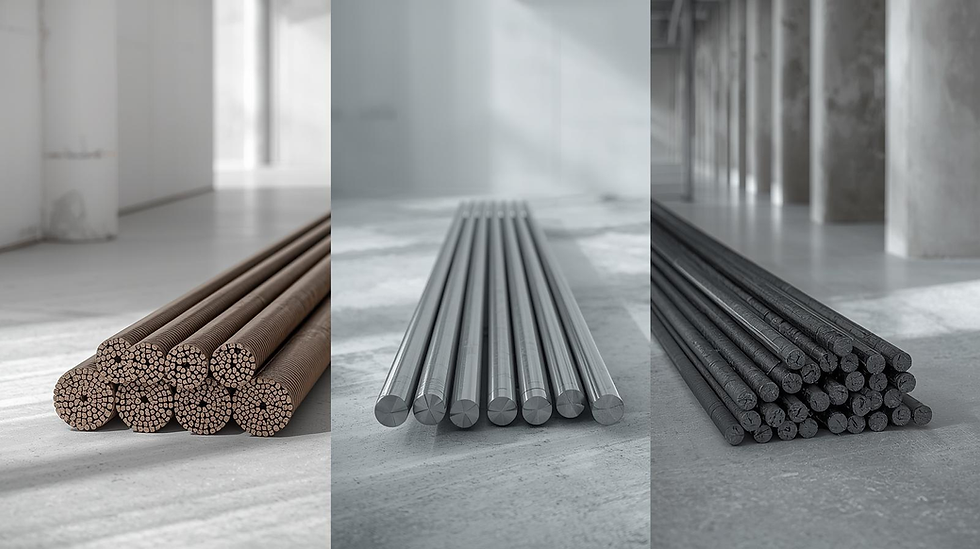The Science Behind FRP Rebar: Materials, Strength, and Performance
- Kamal Sharma
- Dec 18, 2024
- 3 min read
Strength and durability are one of the main pillars of the construction business. That is why for many years, reinforced steel rebars have been the choice for most civil engineers. But, with the increasing seismic activities, unpredictable environment, and harsh weather conditions, modern architecture needs something more. This is where FRP rebar or Fiber Reinforced Polymer rebar comes in. This advanced material offers many benefits over traditional steel rebars. Let’s explore what type of material FRP rebar is, how strong is it and its various applications in this blog.
What Type of Material is FRP Rebar?
FRP or Fiber Reinforced Polymer is basically made from a composite of polymer matrix that is reinforced with fibre material. This material comes in various types depending on the fibre. The most common type of fibres are glass (GFRP), carbon (CFRP), and aramid (AFRP). These fibres are embedded in various polymer resins like Epoxy which offers excellent adhesion, chemical resistance, and mechanical properties.
On the other hand, they are also mixed with Vinyl Ester which provides good chemical resistance and mechanical properties at a lower cost than epoxy. Another polymer resin is Polyester, which is one of the most cost-effective options, but with lower mechanical properties and chemical resistance compared to epoxy and vinyl ester. Such Materials bind the fibers together and provide the rebar with its structural integrity. Now let’s see what each type of fiber brings:
Glass Fibers (GFRP): These fibers are known for their high tensile strength and as well as cost-effectiveness. Moreover, these glass fibers are the most commonly used in FRP rebar.
Carbon Fibers (CFRP): Carbon fibers have the property of providing exceptional strength and stiffness. This alone makes them ideal for applications that require high performance. However, they are relatively more expensive than glass fibres.
Aramid Fibers (AFRP): Aramid fibres are known to provide excellent impact resistance and durability. Such incredible properties make them suitable for applications where resistance and durability are the top priorities.

What Advantages Does FRP Rebar Offer in Terms of Strength and Performance?
According to industry experts, FRP rebar has twice the tensile strength of steel and weighs up to half as much. The material is also resistant to rust, making it more durable and requiring less maintenance. Therefore, FRP rebar outperforms steel rebars in terms of strength, weight and resistance quality:
Corrosion Resistance: FRP rebars are very corrosion resistant. Unlike steel rebar, which can rust and weaken over time, FRP rebar is resistant to moisture and chemicals. Thus, making it ideal for use in harsh environments.
High Tensile Strength: This construction material has high tensile strength, even exceeding that of steel rebar. This allows for more efficient structures without compromising on strength.
Lightweight: It is also significantly lighter than steel rebar, making it easier to handle and transport. Thus, leading to low labour costs and faster construction times.
Non-Magnetic and Non-Conductive: FRP rebar is non-magnetic and non-conductive, making it suitable for applications where electromagnetic interference or electrical conductivity is a concern, such as in MRI facilities and electrical substations.
Fatigue and Impact Resistance: Lastly, it also demonstrates excellent fatigue and impact resistance, ensuring long-term durability and performance in demanding applications
What are the Applications of FRP Rebars?
Now let us tell you about the real-world uses of this material. FRP rebars are extensively used in marine structures like docks, piers and seawalls for their excellent moisture resistance. Furthermore, their higher durability also makes them ideal for bridges and highways. Their strength is well suited to be used in various buildings and various infrastructure projects.
Furthermore, they are extensively used in chemical plants and facilities of that nature for your resistance to chemical corrosion. Finally, FRP rebar's non-magnetic and non-conductive properties make it ideal for use in tunnels and underground structures where electromagnetic interference is a concern.
Conclusion
Therefore, as you can see, FRP rebar is an excellent construction material that can solve the problems that we mentioned at the beginning. They are more durable, light, and resistant to both chemical and moisture corrosion. The best material that can meet modern challenges.



Comments